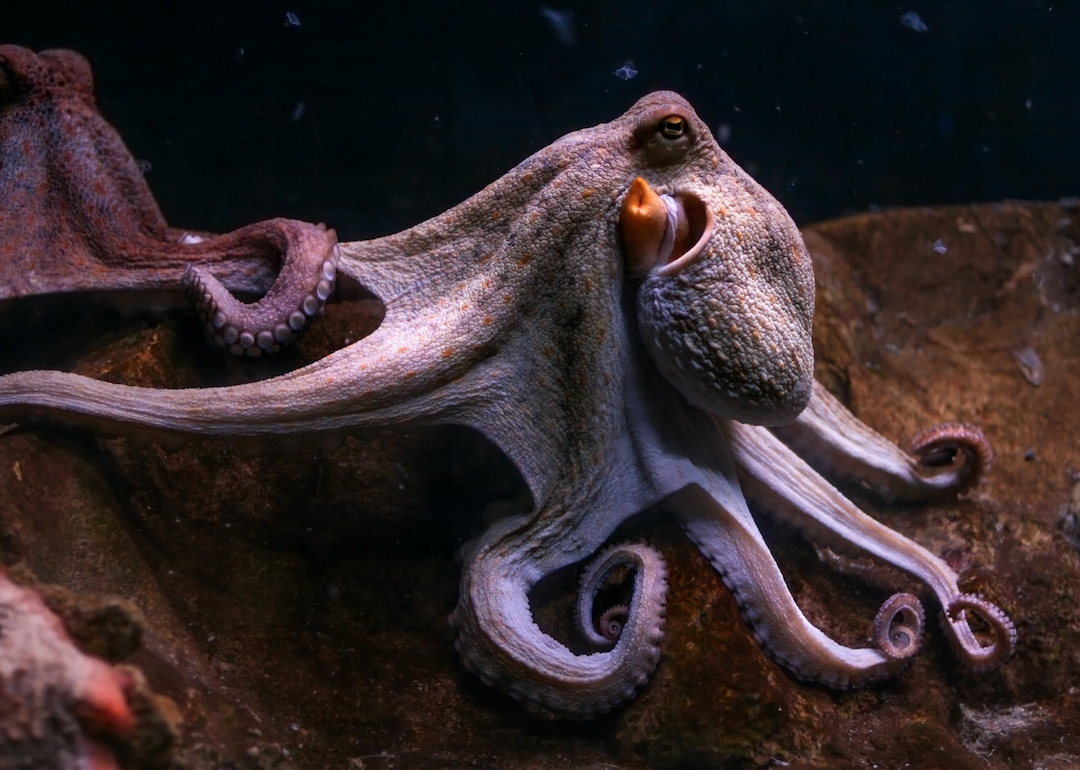
From poison dart frogs to hagfish slime: 20 animal defenses
From poison dart frogs to hagfish slime: 20 animal defenses
All animals need to defend themselves. Humans tend to think of nature as a place of freedom and beauty, but for an animal, it’s dangerous out there, and a lot of those threats are other creatures that want to eat you. So animals have evolved an amazing range of ways to counterattack or avoid being attacked in the first place. Stacker gathered 20 examples from scientific studies and natural-history literature—some representative of strategies found throughout the animal kingdom, and some pretty uniquely weird.
While some say the best defense is a good offense, nature doesn't always agree. There are risks and costs to responding to every attack with a counterattack, especially if your opponent is bigger than you are. So some animals have evolved passive defense techniques. Maybe the most basic is to have a body that's covered with a barrier—a hard shell that's difficult to penetrate, or sharp points that make it hurt when another animal tries to grab or take a bite. Camouflage works, too: Avoid being attacked in the first place by simply not being seen because you blend into the background. Or, another way to use your appearance as a defense is to mimic another animal that your foe is afraid to attack. Predators know that certain species taste bad or sting, so looking like one of those nasty critters wards them off. These mimics are often so precise it's hard to believe, but evolution has produced them over and over: The more an individual looks like the avoided species, the likelier it is to survive and have offspring that look like it, so the imitation gets better and better over time.
Other strategies are more active. There are animals that use chemical weapons, like venom or poison (yes, those are different, as we'll explain) and noxious sprays. Others rely on confusing or distracting their attacker: behaving like they're dead or injured, say, or blocking their vision with a cloud of ink. And some use physical counterattacks that are unusual to say the least, as you'll see.
Read on to learn about 20 animal defenses.
Dart frog: poison
Frogs in the family Dendrobatidae are known as poison dart frogs or poison arrow frogs because the toxin exuded by their skin was used by humans to poison the tips of arrows. Most are also brightly colored to warn predators that they are dangerous to eat. Dart frogs are widely kept as pets, which is perfectly safe: They are not poisonous in captivity because the toxin derives from the insects they eat in the wild.
Inland taipan: venom
Venom and poison are not the same: Poison makes you sick if you bite the animal, and venom makes you sick if the animal bites you. The primary function of venom is to disable the snake’s prey but it can also serve as a defense against predators. Possibly the most dangerous venomous snake is the inland taipan of Australia, which has the most toxic venom and injects the largest amount with each bite.
Squid: ink
Squid ink is more than an ingredient for pasta dishes: It’s an incredibly clever defense. A squid will squirt out a cloud of ink when being chased by a predator. This not only makes it harder for predators to see the squid, it may even fool them into biting at a glob of ink, thinking it’s the tasty creature they’re hunting.
Bombardier beetles: hot chemical spray
Many insects use an irritating chemical called benzoquinone as a defense against predators, but bombardier beetles take this to the next level. They combine ingredients to produce it inside their bodies at the moment of use, and the chemical reaction heats almost to the boiling point and provides the pressure to eject a spray from their abdomen.
Hagfish: slime
The hagfish is unusual in many ways, including its lack of a jaw and backbone, but most of all for its unique and uniquely gross defense. When it’s attacked or just stressed out, special glands produce about a teaspoon of slime that instantly expands in size 10,000 times. Even a shark will gag and spit the hagfish out and go look for a less slimy meal.
Eurasian roller: vomit
There’s a less fancy way to expel something repulsive as a defense: just throw up. The nestlings of the Eurasian roller upchuck noxious orange vomit when disturbed. Like the dart frog’s poison, it’s thought to contain chemicals derived from the insects in its diet, and experiments show that it’s distasteful to potential predators.
Clownfish: borrowed stings
Sea anemones have stinging tentacles that they use to capture prey. The clownfish is immune to their toxin and lives among them, safe from predators. It’s not a one-way relationship, though: The clownfish pays back in several ways, including providing nutrients and helping provide oxygen, aerating the water with its swimming motions.
Three-banded armadillo: rolling into an armored ball
All species of armadillo have a shell made of hard bony plates covered with a layer of keratin that provides a tough barrier to predators. The three-banded armadillo takes this defense a step further: It’s the only species that can roll up into a ball with its head and legs tucked inside. When they’re rolling up, the shell snaps shut on their assailant, providing an additional deterrent.
Robber fly: look like something dangerous
Many animals defend themselves by looking like another animal that predators don’t want to mess with. The robber fly doesn’t have a sting, but it looks like a bumblebee, so insect-eating creatures leave it alone.
Stick insect: camouflage
Looking like something else can also be a different kind of defense strategy: If predators can’t see you, they won’t know you’re there. Stick insects are found all over the world and have evolved to look like astonishingly precise imitations of the vegetation they live among. Some even add to the disguise with their behavior by gently waving like a leaf in the wind.
Mimic octopus: transforming camouflage
Evolving to look exactly like one other animal works, but what if you could imitate different animals depending on the situation? That’s what the mimic octopus can do. It’s been observed transforming to look like at least 15 other kinds of sea life from venomous sea snakes and lionfish, to flatfish camouflaged against the ocean floor.
Burrowing owl: acoustic mimicry
Imitating the way another animal looks isn’t the only kind of mimicry that animals use as a defense. The burrowing owl lives in ground squirrel burrows, which are also frequented by rattlesnakes. They can produce a hiss that sounds like a rattlesnake’s rattle that frightens intruders away.
Ribbed newt: turn bones into poison spikes
The Spanish ribbed newt has a unique, bizarre defense that sounds like it must hurt itself as much as it hurts its attacker: It pushes its own sharp-pointed ribs through its skin. On top of that, like most amphibians its skin secretes a poisonous substance, so any predator that tries to eat it gets a mouthful of toxic spines.
Japanese honeybee: roast your enemy alive
When a giant Japanese hornet invades their nest, Japanese honeybees gather around it in a tight ball and begin to vibrate their wings, generating heat and carbon dioxide. They’ve evolved the ability to withstand the resulting temperature of 46 degrees Celsius that’s enough to kill the hornet.
Hedgehog: spines
In a number of species of mammals, hair has evolved into stiff, pointed spikes. Hedgehogs add to this defense by rolling into a tight ball completely covered with spines, protecting their head and soft underparts. When the predator drops the spiky ball, the spines also serve as a shock absorber to cushion the hedgehog’s fall.
You may also like: Best dog breeds for hunting
Lizards: tail loss
Many types of lizards can lose their tail when attacked and later grow it back. It may wiggle for a few moments after detaching, distracting the predator. If the lizard is bitten on the tail by a venomous snake, this prevents the venom from reaching the rest of their body.
Hognose snake: playing dead
When disturbed, a hognose snake will first put on a display of attacking, but if that doesn’t work, it will pretend to die—writhing as if in pain and ending up flat on its back with its mouth open and no signs that it’s breathing, emitting a foul-smelling liquid. This convincing display may persuade predators that it’s not safe to eat.
Killdeer: playing injured
The killdeer feigns injury to lure predators away from its nestlings. Fluttering along the ground as if its wing is broken, it looks like easy prey, so the attacker is drawn away from the eggs or helpless youngsters.
Duck-billed platypus: venomous spurs
Snakes aren’t the only animals that produce venom, and biting isn’t the only way to use it. The platypus, one of only two egg-laying mammals on the planet, is also one of the few venomous mammals. Male platypuses have glands in their abdomen that produce the venom and a hollow spur on their hind legs to deliver it.
Texas horned lizard: shooting blood from its eyes
The Texas horned lizard is well camouflaged in its environment by its mottled skin, but if that doesn’t work, it’s got plenty of other strategies to try. First, it turns its side to the predator to show it what it’s getting into—a long body lined with spines—then, it puffs itself up to look more threatening. If that’s not enough, it squirts a jet of blood out of its eyes that contains noxious substances derived from its diet of insects.



